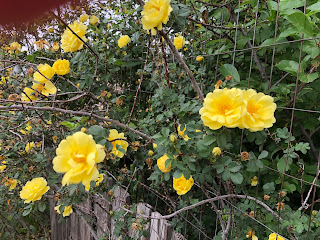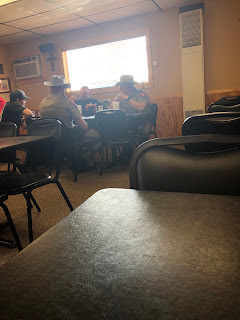This yellow rose was climbing over an abandoned house on the outskirts of the city. I think it is rosa banksiae or very similar.
Route 66 skirts the modern downtown going through the San Jacinto Neighbourhood which is lively and full of antique and "alternative" shops.
On the Road out of Amarillo, I passed the tail-end runners in a Marathon for Cancer Research. With about four miles to go, they were heading for a 6 hour plus finish. I felt their pain.
The roadside verge had a range of wildflowers.
 |
| An allium species, a member of the onion family |
 |
| Gooseberry-leaved globemallow sphaeralcea grossulariifolia |
The "Cadillac Ranch" is a well-known sight just off 66. It was/is an art installation commissioned by a Texan millionaire in 1974. Ten Cadillacs are buried, nose down, in the ground. Since the installation, they have been graffitied by visitors and when efforts to prevent this failed, the owner gave up. It is the most depressing sight. The cars stand in a wet, muddy hole and the "graffiti artists" just abandon their spray-cans when empty. They are cleaned up by volunteers from the Route 66 preservation society, but it is a losing battle. One "artist" was so eager to make his mark, that he climbed up the car, even though this caused the frame to buckle. Never mind anyone or anything else - just get what you want. Is this sight a metaphor for America? The ultimate disposable society. Even attempts to recycle (by turning a commodity into art) is thwarted by the "Me First" culture. You could write a book.
These are stations where young cattle are brought in from the fields for fattening on corn and grain. They are kept here for months. There are thousands of them. What price animal welfare? Maybe someone should send these to Theresa May as she tries to negotiate a trade deal with the US. Unsurprisingly, this aptly named cafe has gone out of business. How anyone could eat within miles of this place is unfathomable. The town near which these were taken is called Wildorado.
On the road into Vega is this mural of pronghorn. As the place is surrounded by ranches for cattle, I think this is nostalgic rather than optimistic. I have seen herds of pronghorn in Wyoming in Grand Teton. They are the "antelopes" in the song "Home on the Range" where "the deer and the antelope play". The deer are probably elk, although there are also mule deer in this area. Along with the buffalo, these animals were pretty much wiped out as the cattle ranches extended west in the 19th and early 20th centuries.
Vega also has a nicely restored Magnolia gas station. Magnolia was a brand of a Texas based oil company dating from 1894. It was replace by Mobilgas, which still exists, in 1934.
When I watched "cowboy and indian" films as a kid, I thought that the sets for them were just made-up - fantasies of the film-makers. It is always a shock to realise that the frontier towns depicted were true-to-life - and still exist. This is Vega's downtown.
As the smell from the cattle station was now only faintly blowing on the breeze, I called in at the only cafe open. From the cop cars parked outside, either they were under siege or the food was good. The cops were right. Best Philly Cheesesteak ever.
There is a museum of barbed wire in Texas, the technology of this developing like any other. Designs were attributed to the ranch owners.
Just outside of town was another example of repurposed trash - a charming one. These are made from metal. Another reminder of a lost past. Buffalo, or more accurately bison, roamed in the millions until slaughtered by the "white men" pushing west. They were no match for the new rifles and an easy source of meat, hides and bone which were traded up and down the trails. In 1889, it was estimated there were less than 600 left. They are now largely confined to the National Parks and still threatened, with around 30,000 left. Don't even mention the passenger pigeon.
 |
| Purple groundcherry quincula lobata |

These little beauties were closeby.
Soon after, I reached the mid-point of the journey! Which is slightly daunting as I have actually driven a few hundred miles more than this.
Time to celebrate with a piece of pie (although I still haven't eaten it) at the Mid-point Cafe.
The terrain rapidly changes as you approach the border with New Mexico, with these rocky outcrops a foretaste of what is to come.
Glimpsed through the trees on I40 you can just see the archway proclaiming that you have crossed the border at St Jon, which is just a collection of ruins.
66 becomes a gravel road for 18 miles at this point, although well-maintained. I was hesitant to try it, until I saw a cloud of dust in the distance and soon after a Ford Mustang convertible, hardly an all-terrain vehicle, came tearing up the gravel at about 40 miles an hour. Two young Swiss, who assured me that I would be fine in my little SUV (they clearly thought I was nuts to even question it).
The remains of the old railroad can be seen running alongside.
More flowers. The purple ones have been appearing since western Oklahoma. These were all seen between St Jon and Bard.
 |
| Indian blanket or Firewheel gallardia pulchella |
 |
| Feather-leaf fleabane erigeron grandiflora, I think |
 |
| Another picture of the globemallow |
 |
| Rose verbena glandularia canadensis probably. And daisies. |
More about Tucumcari tomorrow.



































No comments:
Post a Comment